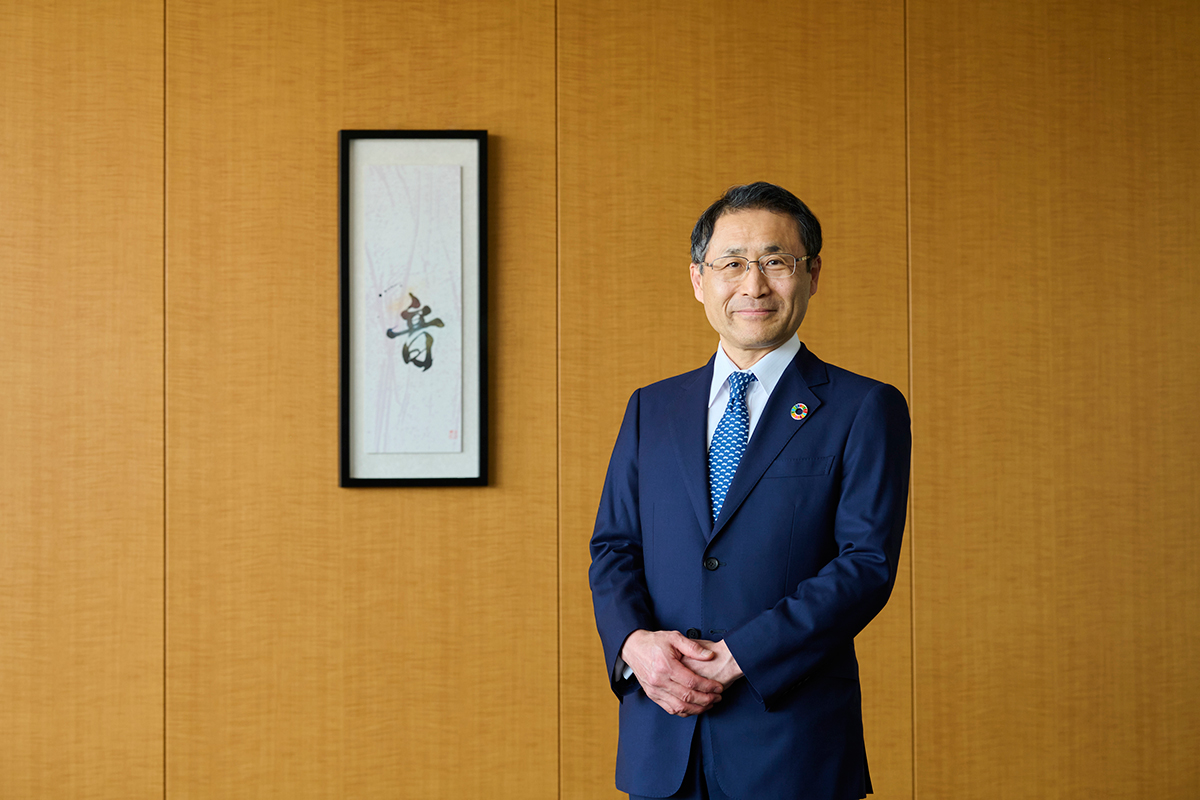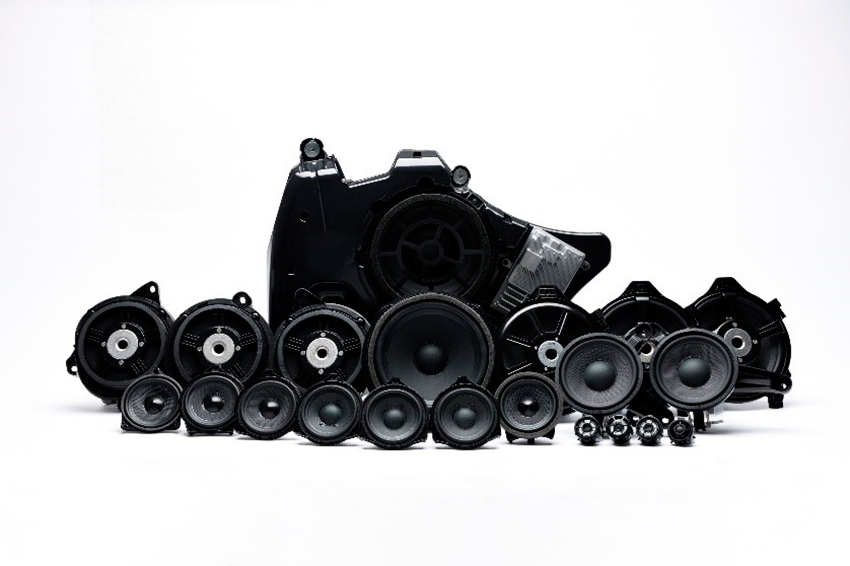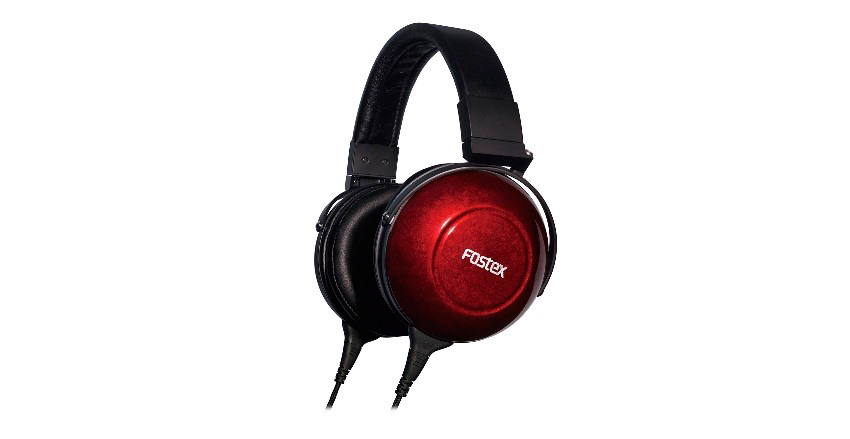On the backdrop of a strong financial performance in the first half of FY 2023, Foster Electric is solidifying its position as a leading OEM for audio equipment and strengthening its competitiveness in the booming in-vehicle speaker market.

Could you give us your take on the so called “rise and fall” of Japan’s electronics industry?
The reason I think the Japanese electronics market is considered weak is that it once had the strength of the mass consumption market. One of the reasons why the Japanese electronics industry has lost its power in the mass consumer market is that in the 1990s the Japanese economic bubble burst and companies became afraid of making investments in the B2C market. The market itself was seen to fluctuate quite drastically, so taking this much of a risk became a hurdle for Japanese companies, preventing them from continuing to excel in B2C markets. Having said that, while from a B2C perspective Japan’s electronics industry may look like it is shrinking, from a B2B perspective it is totally the opposite and Japanese firms are leading the way.
B2B has been a good market for Japanese companies as it is more based on orders from customers, so companies can foresee, plan, and avoid risk. Longer product cycles allow businesses to plan their strategy on the market much better. The characteristic of B2B is not one-sided where the customer demands specifications and the supplier provides those demands. In fact, there is co-development from scratch, therefore there is involvement from both parties to create the product.
The key to B2B is that customers provide suppliers with requests for quotation (RFQ) and in order to create this RFQ there is a dependency on how much your company is involved. This involvement will then determine if you receive the order or not. Japanese in general are very collaborative and as a nation, we are very good at teamwork. It gives us a competitive edge as Japanese firms will work hard to find negotiable points to reach agreements.
Our own company’s biggest strength right now is in vehicle speakers, and it actually came about thanks to the expansion of our foreign customers. In Japan, there are a number of similar brands, so at first our share in the domestic market was low. Nowadays for in-vehicle speakers, we have around 30% of the global market share.

Foster is a great example of the B2B excellence of Japanese firms that you described. There must be a reason why companies choose you time and time again as a collaborator. Could you give us your perspective on why that may be?
First of all, we have deep knowledge of acoustics, secondly, we have the necessary developing capability, and thirdly we can mass produce as well as replicate that high quality, but unfortunately, I think all companies would say that they have these competencies. What distinguishes our company over others is the teamwork spirit we possess. Our employees are so loyal to the customers. They are so focused on how to make a contribution to the clients.
One of your big points there was your ability to mass produce with high quality. This particular point proved difficult during the COVID-19 pandemic. We saw many companies struggle with logistics problems, chip shortages, and geopolitical changes. As a result, we see many companies trying to shorten their supply chain by localizing not only manufacturing but also material procurement. Coincidently your company has announced that it would open an EU production base. How did you guide Foster through these turbulent times, and what changes are you bringing to your supply chain as a result of the past 3 years?
I think our strengths lie in the answer to your question. During the pandemic all of our customers were afraid of supply chain disruptions and requested that we maintain the supply chain throughout, however, each country where we have factories, like China and Vietnam, had their own situations with lockdowns. We did not halt a single one of our supply chains, and the reason we were able to do that is the Vietnamese government allowed work to continue inside the factory. Although work was able to continue it was required that workers not come and go from the factory, so we were fortunate that 80% of our employees volunteered to stay in the factory for over two months to keep working. In order to maintain the supply chains of our company they made tremendous efforts living in the factory for over two months. For two months those employees were separated from their families and some family members would even come up close to the fence to see them, even though because of lockdown orders they couldn’t touch their family.
What do you think motivated those employees that much?
That is hard to answer, but I would say that we do not impose Japanese systems when expanding overseas. We prefer to run businesses using local styles of management. For basic quality assurance (QA) we have to set a standard, but aside from that, we ask the locals to run things their way. Majority of the employees in both the Chinese and Vietnamese factories are locals who have a strong sense of unity.
Your company recently announced a joint venture with Yokodan Group to help with material procurement for ferrite magnets used in speakers. Could you tell us more about your decision to get involved with Yokodan for this joint venture, and more about your policies for sustainable and ethical material procurement?
Yokodan which has been our supplier with a great relationship for many years wanted to have a base overseas. The Yokodan group wanted to expand to Vietnam and our company has had bases in Vietnam for quite some time. We used to have five but now the number sits at four. The reason we have been successful is that we have Vietnamese team members in negotiation with the local government. The only hindrance to this Chinese company coming to Vietnam was communication and that was the reason they approached us to do a joint venture together.
Actually, there were three companies that recognized by the Vietnamese government for their contributions to the growth of Vietnam; Foster, Canon, and Samsung. Of course, Canon and Samsung are well known around the world, and I would hazard a guess that we are not as well known.
The in-vehicle speaker market is living an exciting time right now as vehicles transform from internal combustion engines to EVs. The Connected, Automated, Shared, and Electric (CASE) era is coming, and the cabin space inside those vehicles is certain to change almost completely. In one way the cabin is going to become more spacious and luxurious, and in another, EV motors are going to make the cabin much quieter. What impact will these changes have on in-vehicle speakers and the overall end-user experience?
This is a great opportunity for us as with the transformation to EVs taking place, the cabin will become quieter, which means that end-users will inevitably require higher-quality sound. Since we provide very high-quality speakers this is a good business opportunity. One such example is the Chinese market where before they considered our products high-quality but not cheap, but now with the switch to EVs, Chinese companies are flocking to us in order to procure our speakers.
With the advent of CASE, mobility is now becoming infotainment which means there is a requirement for a larger number of speakers inside the vehicles. Additionally, with many of the critical safety components embedded in the cars, they have an alarm or buzzer installed to let the user know of any danger. Our vibration device, “actuator” is also used for same purposes. These two areas are segments where we excel.
With many EVs, they need to compensate for the heavy lithium-ion batteries that are required to have the motors run, so we are seeing a larger demand for lightweight and smaller speakers. We feel this is also a strength of ours.
Is there a particular region that you have in mind for sales of your in-vehicle components and speakers?
Before I mentioned how our business was low in Japan, but we are now seeing it grow thanks to a deal with one of Japan’s biggest car manufacturers. Our customers are so diversified so I think we do have a balanced perspective on our international growth and targets. However, I will say that Chinese takes a completely different style from Japanese, and things need to go their own way. China has the biggest potential market in the world, but as long as we stay as a Japanese company operating in China there will be limitations since there are strict guidelines and rules from the Chinese government for foreign companies there. Last year we actually established a joint venture company with a Chinese partner owning 51% and us owning 49%. From the Chinese point of view, that company is Chinese, but we are able to retain our technology and in China, we can do business through this company. The investors are actually ex-employees of Foster.
China has its own style of business which always requires quick responses rather than the slow and thought-out process we are used to in Japan. Local decisions need to be made quickly in order to catch up with local competitors. I think though, as long as this company is supplying components and speakers to Chinese companies we do not face such great risk.

We saw that you collaborated with NEC for a next-generation Bluetooth headphone. It uses biometric authentication technology as well as ear acoustic authentication, using the ear temperature and canal shape to confirm the user. How do you think headphone and audio tech is going to look 20 years from now?
This is disclosed information so I can discuss it a little with you. We have collaborated with NEC in developing a new technology for headphones that utilized biometric ear recognition, basically using acoustics to recognize a user's ear canal size and shape and determine the identification of the user. Using this technology we are thinking it could be used as a key to unlock cars, computers, or even smartphones. What is unique about this solution is that a person has to wear earphones nearby in order to drive the car or operate the computer. If the person wearing the earphone moves further away the device is no longer accessible. In my opinion, this increases safety. Right now we are trying to figure out some of the applications however it is taking some time since cars have very high safety standards.
The earphones have noise-canceling features and they can pick up clear noise. Another interesting feature is that because of biometric monitoring, the earphones can check a user's blood pressure and temperature. We have seen some interest from construction site companies because of these unique features. The core technology that allows all of these features to work is based on a small white mat that is inside the earphone, it is only 4.85mm in size.
During the COVID-19 pandemic, FOSTER experienced two difficult Fiscal Year results. Interestingly, the latest numbers for 1H FY03/23 show a +30% increase in sales and return to positive operating income. What were the reasons for this turnaround?
The biggest reason is that we transferred the additional costs of material procurement, component fee, and logistics transfer station fee to the customers. While you may think this is a simple approach, it is actually a revolutionary approach in this industry since the trend has been to revise pricing every year and make it lower. In order to keep up with this trend our company has had to keep revising and restructuring our cost structure to make it more efficient cost-wise so that savings can be passed to the customers. For example, for the in-vehicle speakers, we provide the same model for 3-5 years and we have never asked for a price increase. It is because we don’t have a system to absorb this additional cost. At first, we did ask for a cost increase and of course, our customers declined, so we have to be very careful in negotiating each and every component so that we can achieve the most reasonable cost raise. Thanks to the customers that had a deep willingness to work with us we were able to reach a compromise that works for all parties involved. We are a B2B business and that means we are a supplier to our customers. I think in some way we were underestimating our value, and while customers were sending in requests it was around this time I realized that these customers actually need us too. Once I reached this understanding it became easy to approach the situation by making our own requests. At first, it was only a one-time price change, but after negotiating we were able to make it a cost link system and the price now changes according to the cost. I think we are the first company in the market to create this cost-link system.
Imagine that we come back and have this interview all over again on the last day of your presidency. What goals or dreams would you like to have achieved by the time you are ready to pass the baton onto the next generation of Foster executives?
Aside from numerical targets, my main objective as president is to focus on my employees and the company structure as a whole. Our company’s employees are very diligent and very sincere. As president, I feel it is my duty to create a working environment where they can fully exercise their potential and simply be happy with the work that they do. It is important for me to create a company structure where that goal is sustainable and the environment allows those employees to thrive.
Even if the employees were to be able to exercise 100% of their potential if the company is not sustainable, that is a complete waste of their talents. It is my job to balance the company and the employee's needs, leading the way to the future of Foster. It is a difficult path, but I embrace the challenge.
0 COMMENTS